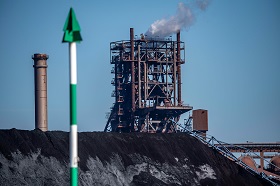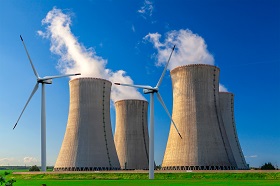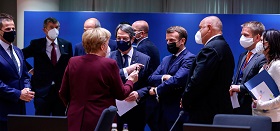Energy transition entails a number of major geopolitical challenges, requiring a transformation of the EU strategy for collaboration with regions and nations, certainly including Russia, which have played a particularly great role in ensuring the EU’s energy security.
The first challenge lies in altering the pattern of interdependence with the Middle East and North Africa (MENA) as well as Russia. The EU’s transition to renewable energy sources (RES) reduces its dependence on hydrocarbons from those regions, especially after 2030, when gas consumption is to be decreased. For MENA nations and for Russia, this entails a major drop in national budget revenues, and it will require a transformation of the economic model, possibly producing social instability in some of these states. The latter is particularly important for the EU owing to the situation concerning migration in the Mediterranean. The EU has already been quick to adopt visionary documents to establish a new framework for shaping a new pattern of interdependence.
The second challenge the EU faces in developing RES is to preserve and advance its regulatory influence in the neighboring regions. This challenge stems from a decline in interdependence potentially shrinking the EU’s influence on the direction in which these states develop, pushing them to diversify partnerships and look for cooperation with potential rivals of the EU that do not tie their investments to any democratization and human rights commitments. For North Africa, this primarily means China, whose investment in RES and overall trade volume with the Southern Mediterranean is steadily growing. There are similar justified concerns that Russia might increase its eastward exports following a drop in hydrocarbon exports to the EU, though its dependence on China might grow accordingly. We should add China’s increasing technological competitive edge, particularly in solar energy.
The third challenge, largely stemming from the first two, is the need to intensify diplomatic dialogue with international partners—for a “green deal” not to be perceived solely within the realistic paradigm as a zero-sum game but rather as improving one’s own competitive edge by creating barriers in the way of others. Citing political differences as reasons for ignoring opportunities to cooperate with certain states in combating climate change will definitely harm the EU’s reputation as a globally responsible leader. So, pursuing dialogue is more of a necessity than a choice in this case.
For Russia, the challenge is not only to adapt to the inevitable contraction of the hydrocarbon market and to diversify its economy but also to make sure the country seizes the opportunities to do business in other countries and regions. In particular, it remains to be seen how the EU’s new African and Mediterranean strategies affect the prospects for Russia’s regional economic presence, which is largely associated with energy projects. After all, the question for Russia is how not to fall by the wayside of the new European green deal and China’s Belt and Road Initiative, as the interests behind the two projects inevitably overlap in the Mediterranean. Will Russian companies have enough competitive edge to participate in international “green” energy projects? Won’t Russian companies be excluded as not complying with the new environmental standards? Could Russia become a rule-maker in the global green deal rather than a mere rule-taker?
Russia is unlikely to receive assistance in exploring its own internal capabilities and need for RES. The principal actors here are, traditionally, the state, businesses and the civil society that particularly articulates the need for “going green” and introducing climatically neutral innovations. Yet, since this need has been recognized and expressed, it is high time Russia looked for potential partners. On the one hand, such partners would need to be sectoral technological leaders capable of sharing best practices in implementing domestic projects while simultaneously “guiding” Russia in international cooperation projects. On the other hand, such partners should not strive to politicize economic cooperation. The Italian Republic might apparently be just such a partner for Russia.
Italy regards the “green transition” as an opportunity to embark on another stage of international expansion for its technological leaders and, unlike many other EU states, is not inclined to politicize economic cooperation. It was largely Russia and Italy’s energy cooperation—launched at a time of fierce inter-bloc confrontation and delicate energy diplomacy in the relations with the USSR and the states of the Southern Mediterranean—that allowed Italy to gain the status of a middle power in the second half of the 20th century.
Russia has put forward various assessments of the European Green Deal approved by the European Union in 2019, marking the intensive stage of energy transition. Some experts prefer to stress that developing green energy in the EU is another step in putting an end to energy dependence on Russia and the unstable states of the Middle East as well as a way to build up the EU’s competitive edge by making more efficient use of resources, developing new technology-intensive sectors and imposing a carbon border tax on carbon-intensive products from outside the EU. In this case, combating climate change is the niche where the EU is attempting to expand its own global role and where the EU has quite a shot at leadership. This realism-based approach calculates Russia’s possible losses and focuses on ways to minimize them. Another opinion, more typical of the liberal paradigm, is based on the premise that the EU—if acting on its own—is, a priori, incapable of achieving the desired results in combating climate change, since it is not the main polluter on the planet, while China, the U.S., India and Russia account for the bulk of emissions. So, without truly global cooperation, the EU can hardly achieve its goals. Consequently, an era of new opportunities is opening up for increasing collaboration under the slogans of shared responsibility for saving the planet. In his Address to the Federal Assembly, Russia’s President Vladimir Putin paid unprecedented attention to preventing climate change and environmental pollution, which demonstrates a clear trace of the EU’s new climatic agenda and a desire to show that Russia is not alien to the universal human values of fighting for quality of life in the future.
No matter what, it is expedient for Russia to account for both the realist and the liberal arguments and, on the one hand, to research opportunities and take steps for improving its own competitive edge and, on the other hand, to take advantage of the chance to use interdependence and reset relations with the EU on the basis of the new global “green” agenda.
New geopolitics of the EU’s “green energy”
Energy transition entails a number of major geopolitical challenges, requiring a transformation of the EU strategy for collaboration with regions and nations, certainly including Russia, which have played a particularly great role in ensuring the EU’s energy security.
The first challenge lies in altering the pattern of interdependence with the Middle East and North Africa (MENA) as well as Russia. The EU’s transition to renewable energy sources (RES) reduces its dependence on hydrocarbons from those regions, especially after 2030, when gas consumption is to be decreased. For MENA nations and for Russia, this entails a major drop in national budget revenues, and it will require a transformation of the economic model, possibly producing social instability in some of these states. The latter is particularly important for the EU owing to the situation concerning migration in the Mediterranean. The EU has already been quick to adopt visionary documents to establish a new framework for shaping a new pattern of interdependence. On March 9, 2020, the European Commission announced the EU's comprehensive strategy with Africa, which includes five priority partnerships: green transition, digital transformation, sustainable growth, peace and governance, migration and mobility, also intending to usher in an era of closer cooperation with African states. In February 2021, the new “Agenda for the Mediterranean” was presented in Brussels, claiming that the COVID-19-induced crisis in the region gives Europe and other regional nations a unique chance for cooperation geared towards environmental, digital, sustainable and fair recovery. The overall funding for the “Agenda” under the Neighbourhood and Development and International Cooperation Instrument (NDICI) will total €7 bn (possibly increasing to €30 bn). Five of the twelve priority cooperation areas have to do with green transition, sustainable development, regional connectivity, digitization, green growth and climate.
On the one hand, the new stage in the EU’s cooperation with the Mediterranean states seeks to help them avoid the negative consequences of economic restructuring and to promote economic development and social stability in the region by introducing new technologies, improving the environment and creating new jobs. On the other hand, the EU itself is entering into a state of a new dependence on the states of the Southern Mediterranean since it needs the wind and solar power that abound in the region. So, the EU is extremely interested in establishing and implementing new partnerships as fast as possible. In particular, the Germany-Morocco hydrogen energy partnership is already in place, while French companies are developing wind and solar energy in Tunisia. Construction of interconnectors between the Northern and Southern Mediterranean has received a new impetus. In particular, Italy and Tunisia are building the Elmed interconnector to link Tunisia’s power grid with the European grid in 2025, with Morocco having launched energy exports to Spain in 2019 via seven underwater cables connecting the two states.
The second challenge the EU faces in developing RES is to preserve and advance its regulatory influence in the neighboring regions. This challenge stems from a decline in interdependence potentially shrinking the EU’s influence on the direction in which these states develop, pushing them to diversify partnerships and look for cooperation with potential rivals of the EU that do not tie their investments to any democratization and human rights commitments. For North Africa, this primarily means China, whose investment in RES and overall trade volume with the Southern Mediterranean is steadily growing. There are similar justified concerns that Russia might increase its eastward exports following a drop in hydrocarbon exports to the EU, though its dependence on China might grow accordingly. We should add China’s increasing technological competitive edge, particularly in solar energy.
The third challenge, largely stemming from the first two, is the need to intensify diplomatic dialogue with international partners—for a “green deal” not to be perceived solely within the realistic paradigm as a zero-sum game but rather as improving one’s own competitive edge by creating barriers in the way of others. Citing political differences as reasons for ignoring opportunities to cooperate with certain states in combating climate change will definitely harm the EU’s reputation as a globally responsible leader. So, pursuing dialogue is more of a necessity than a choice in this case.
Russia: a forced rule-taker?
For Russia, the challenge is not only to adapt to the inevitable contraction of the hydrocarbon market and to diversify its economy but also to make sure the country seizes the opportunities to do business in other countries and regions. In particular, it remains to be seen how the EU’s new African and Mediterranean strategies affect the prospects for Russia’s regional economic presence, which is largely associated with energy projects. After all, the question for Russia is how not to fall by the wayside of the new European green deal and China’s Belt and Road Initiative, as the interests behind the two projects inevitably overlap in the Mediterranean. Will Russian companies have enough competitive edge to participate in international “green” energy projects? Won’t Russian companies be excluded as not complying with the new environmental standards? Could Russia become a rule-maker in the global green deal rather than a mere rule-taker?
As conventional wisdom has it, if you want to grasp the rules of the game quickly, you should start playing it. And if the rules have not been fully set yet, it is crucial to join the game in time.
Institutionally and rhetorically, Russia adheres to combating climate change and environmental pollution. Russia has ratified the 2019 Paris Accords, adopted a series of internal strategic documents, such as the National Action Plan for the First Stage in Adapting to Climate Change up to 2022 and then The Russian Federation’s Long-Term Development Strategy for Low Greenhouse Gas Emissions up to 2050. The country has also developed a series of national climate and environment projects. In reality, however, Russia’s progress in the area has witnessed few successes. In particular, in 2021, Russia was ranked 73rd out of 115 states in the annual World Economic Forum’s ranking measuring how much states progress in transferring to clean energy, while the share of wind and solar power in Russia’s UES balance is only 0.15%. Calculations indicate that—should the most ambitious plans be implemented—the RES share in Russia’s energy generation will have reached 2–2.5% by 2035. At the same time, Russian companies have been rather active in going “green”, launching “clean” detachment of “dirty” assets into separate subsidiaries in order to attract investment and export their products to the EU while leaving products with a high carbon footprint for the domestic market. Owing to the absence of a domestic market, “green projects” launched in Russia, such as RES and hydrogen equipment, are clearly export-orientated. Russia is unlikely to receive assistance in exploring its own internal capabilities and need for RES. The principal actors here are, traditionally, the state, businesses and the civil society that particularly articulates the need for “going green” and introducing climatically neutral innovations. Yet, since this need has been recognized and expressed, it is high time Russia looked for potential partners. On the one hand, such partners would need to be sectoral technological leaders capable of sharing best practices in implementing domestic projects while simultaneously “guiding” Russia in international cooperation projects. On the other hand, such partners should not strive to politicize economic cooperation. The Italian Republic might apparently be just such a partner for Russia.
Italy as a RES leader
Italy is certainly a leader in developing RES. The desire of one of the EU’s most energy-dependent states to reduce this dependence is quite rational and justified. In 2019, renewable energy sources—such as solar, wind and hydropower—accounted for about a third of its total energy generation. About a fifth of Italy’s demand for heating and refrigeration is covered by RES, which is slightly above the average in the EU. In transportation, RES account for 7.6% of total end-consumption of energy, which is a little below the average EU level.
Throughout 2010 to 2019, Italy ranked 7th in the world in terms of accumulated investment in renewable energy sources (USD 82 bn), coming ahead of France, Brazil and Spain. By 2020, Italy had reached the target indicators for the RES share in its energy consumption ahead of schedule (17.8% in 2018, 14th place in the EU). Italy is Europe’s leader in geothermal energy generation. In 2017–2018, Italy ranked second in the EU when it comes to solar energy generation, third in producing biogas, second in hydropower, and fifth in wind energy generation. 33% of the electric energy consumed in Italy in 2018 was generated from renewable sources, with hydropower accounting for 60%. Italy also ranked 6th in the EU in 2018 in using biofuel in transportation and 4th in generating primary energy from municipal waste. Italy’s National Energy and Climate Plan (NECP) sets the goal of having RES account for 30% of its gross end-consumption by 2030, which the EU judged to be quite ambitious. Under the NECP, Italy is on the way to achieving the EU’s 2030 goals. Implementation of this plan will cut greenhouse gas emissions by 33% (emissions not covered by the trading systems (transport, residential construction, agriculture, and waste)). To achieve this ambitious goal, Italy plans to increase solar energy generation from 19 GW to 52 GW and wind energy generation from 10 GW to 19 Gw (mostly coastal). Italy is also planning to exceed the EU’s target indicators of having a 14% RES share in transportation and to reach a 22% share by using biofuel that is three-quarters biomethane. Experts believe this goal to be quite feasible, since Italy today has Europe’s biggest fleet of cars running on gas. A study of five EU states in 2021 (Germany, France, Italy, Spain, and Poland) ranked Italy first in generating, consuming, managing waste, investment, and engagement in waste processing, repairs, and recycling waste.
Russia and Italy: The importance of bilateral partnership and beyond
Italian and Russian companies have already started cooperating in RES. In particular, Rosnano and Enel Russia intend to implement Russia’s first “green” hydrogen production at a wind power plant in the Murmansk Region. Additionally, the parties are to launch a joint fund for supporting green energy generation in Russia in 2025–2035, each of them investing RUB 36.5 bn (€800 m total). If the Russian leadership is serious about developing RES domestically and exporting hydrogen to the EU, the mutual benefits from the Russia-Italy partnership are apparent given Russia’s potential in wind and solar energy and Italy’s major experience in developing these sectors and technologies. Other promising areas might certainly be waste processing, biofuel production, and use of RES in transport.
Yet, the cooperation potential is not restricted to the bilateral level.
Italy believes energy transition and sustainable development to be a crucial factor in its relations with the nations of MENA as it considers climate change in the region an immediate security threat. Official documents of the Italian Ministry for Foreign Affairs include this aspect among other priorities in developing cooperation with African states. Experts rank very highly the importance of the Mediterranean for developing green energy in the EU in general and Italy in particular, as they do the need to promote a fair transition in especially vulnerable states to avoid a new rise in migration pressure.
Given the energy transition announced by the EU, Russian companies’ prospects with respect to their presence in Mediterranean energy remain rather vague, and the pressure of sanctions makes participation in international cooperation projects increasingly complicated, as the case of Algeria shows. Given that “green energy” has not yet been affected by sanctions and Russia and Italy have accumulated experience of successful regional cooperation (in particular, in Egypt’s Zohr gas field), it would obviously be expedient to analyze the possibilities for Russian and Italian companies to participate in joint RES projects in the Mediterranean.
Since Mario Draghi has become Italy’s prime minister, the country has been strictly following Euro-Atlantic solidarity, yet such cooperation with Russia would not contravene this stance. On the contrary, it would promote Italy’s image as a middle power skillfully building bridges between conflicting parties. Italy sees the “green transition” as an opportunity to embark on another stage of its technological leaders’ international expansion and, unlike many other EU states that have succeeded in developing RES, it is not inclined to politicize economic cooperation. It was largely Russia and Italy’s energy cooperation—launched at a time of fierce inter-bloc confrontation and delicate energy diplomacy in the relations with the USSR and the states of the Southern Mediterranean—that allowed Italy to gain the status of a middle power in the second half of the 20th century.








